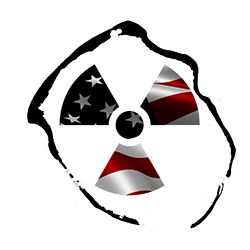Operation Hardtack I
In many ways, the entire story of atomic bomb development was one of systemic cover-up from the Atomic Energy Commission, that radiation was, in and of itself, harmless. They needed to keep this fiction alive at all costs and against all indications to the contrary. Yes, atomic bombs were tremendously powerful and destructive but the lingering effects were absolutely nothing to worry about. This is the oft-repeated mantra heard around the US at the sites where nuclear processing plants were churning out the raw materials for bombs while people outside were dropping like flies, workers and civilians both. The slow, creeping nature of radiation poisoning from alpha particles was becoming apparent and had to be discounted. It was only after the lives of these same Americans began to unravel that the AEC realized it had a major problem on its hands. The knee-jerk reaction became deny, deny, deny. Wherever bomb testing or production facilities came under attack from outside forces, seeking to cap releases of radiation into the environment, the AEC’s enormously powerful disinformation and denial machinery would spin up. Independent researchers were automatically discredited, their study figures slammed as totally implausible. When the public in the US, in states surrounding the Nevada test site, or the various processing sites for nuclear weapons in Washington State, in Utah, in New Mexico, in Colorado, began to suffer enormous spikes in cancer and leukemia rates, the AEC became ever more insistent that testing needed to continue regardless, citing national security. The obvious question then arises that if, in the very creation of these weapons, without even setting them off, you’re actively killing thousands of members of the nation you purport to be protecting, whose security are we talking about exactly?
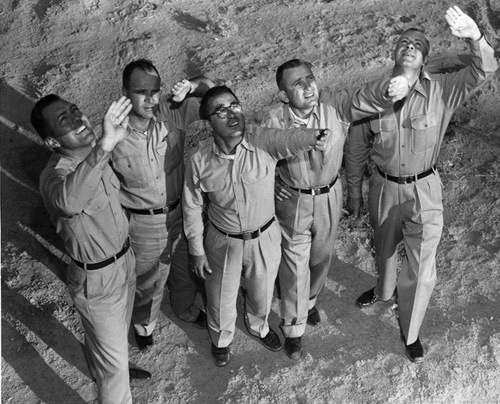 In this bizarre demonstration in Nevada the five ‘volunteers’ stand directly underneath a small airdrop nuclear weapon in order to demonstrate their inherent safety. Of course, they would all die in later years, of cancer.
In this bizarre demonstration in Nevada the five ‘volunteers’ stand directly underneath a small airdrop nuclear weapon in order to demonstrate their inherent safety. Of course, they would all die in later years, of cancer.
Eventually, in September 1957, they conceded to underground testing but this was just an emollient, meant to counter the growing disquiet. In reality, it did very little to prevent the release of radiation clouds into the atmosphere. It vented anyway.The tests in the Marshall Islands, while initially resisted internally at the AEC, became an essential to the program as they required almost no safety measures, either for the islanders or for the servicemen taking part; out of sight, out of mind. All bets were off. 1958 saw the largest test series of all. This was Hardtack I.
Hardtack was the largest series by far up to this point, 35 in all. 1958 saw a total of 77 tests in total, both in Nevada and the Pacific. A number of things spurred the rush to test. Both plutonium manufacturing plants in Oak Ridge and Hanford were operating at full tilt by this point. With plenty of plutonium on hand, new weapon designs were coming thick and fast, all of which needed testing to gather information on their workability. A possible test moratorium was also looming over the horizon added to which a swing in public opinion was beginning to weigh on the negative side of the nuclear issue; it was the beginning of the nascent campaign for nuclear disarmament. Hardtack was the last series to employ atmospheric testing. From here on, they would all be underground. All but two of the detonations were at Enewetak and Bikini Atolls. Hardtack II, all smaller yield tests, were in Nevada.
Charles Dunham, the AEC director of the division of Biology and Medicine complained that the new limits of nuclear radiation exposure proposed by the National Academy of Sciences would preclude any further testing in Nevada. So, in order to eliminate the need to determine radiological fallout safety, Dunham, together with other AEC officials, argued the case for a move of future tests to the Pacific Proving Grounds. After all, the only people that lived there were “happy, amenable savages.”
Lab testing now centered around making weapons deliverable, downsizing without losing destructive energy. By now, the basic principles of what made a nuclear weapon go bang were pretty well understood but lofting a 10,000 lb device and sending it halfway round the planet was a non-starter. Warheads (a new term in the late 50’s) had to be smaller. To this end, the DoD began high-altitude testing as well. Teak and Orange, high-altitude detonations, took place 26 and 47 miles above another test site, Johnston Island, about 700 miles WSW of Hawaii. The electro-magnetic pulse (EMP) phenomenon produced by nuclear weapons was discovered during these tests. The Hardtack program incorporated two aspects, one being the development of the weapons and the second being the measurement of the explosive and radiation effects. The AEC’s primary interest was in weapons design, while the DOD focused on weapons actual effects, specifically concerning the weapons application.
Approximately 16,000 personnel took part in the exercise all told. A large number of aircraft crews were on hand to do monitoring and air sampling before and after every shot.
At least 14 designs given a Mk number, meaning they were destined for positions in the arsenal, were tested during Hardtack. Other developmental designs also came along at this time, like the Mk 41, at 25 megatons, the largest bomb ever fielded by the US as well as the W-53 Titan II, the largest warhead in the US arsenal at 9 megatons. The Soviet Union would go on to produce much larger weapons like the Tsar Bomba, which at 56 megatons remains the largest blast in human history, dropped on October 30, 1961 over Novaya Zemlya, a large island off the northern coast of Russia. This device had a potential yield, if configured differently, of over 100 megatons.A drive to continue testing resided within the testing community itself. The development of nuclear weapons up to this time had been primarily of large-yield, strategic weapons that fit with the established U.S policy of “massive retaliation.” In 1958, some weapon designers felt that with more testing, smaller and more efficient and radiologically “‘clean” weapons could be developed. This development would enhance flexibility in the military support of U.S. foreign policy, and the “cleanness” of the test explosions would also make testing operations themselves less contaminating and so more acceptable to world opinion. Task Unit 7.1.7 had planned a demonstration of the cleanliness of the new breed of weapons for an assembled group of international scientists and UN dignitaries on Enewetak, with a test firing, slated for August 25, 1958 but it was canceled on July 26 due to a lack of interest. It was meant to address growing concerns over fallout. At the time of the cancellation only three, Belgium, Sweden and France of the fourteen nations had agreed to send representation. The Eastern bloc nations, U.S.S.R. and Czechoslovakia and India had declined, and eight had not replied.
The Hardtack series tests would all take their names from native American hardwoods and shrubs. The following is a list of all the Hardtack shots on or around Enewetak. The heavy use of barges during Hardtack saved the meager land area from greater punishment; there were already a number of large craters around the northern atoll wall. When shots were detonated onboard barges, the monitoring equipment was placed by divers on the lagoon floor and recovered after each shot
Yucca was an aerial test of a small, 1.7 kiloton warhead, conducted some 85 miles to the northeast of Enewetak, on April 28, 1958 and detonated from a balloon at 85,000 ft, over open water.

The Cactus test of May 5, 1958 was another small weapon, designed as the primary charge for a larger device, it was a test to see if it had sufficient power for the task, it was a ground shot and doubled as an effects test against some specially erected metal structures. The earlier Redwing Lacrosse test was just offshore of the same spot on Runit and left a similar-sized crater on the reef. Cactus would later serve as the gathering site for all the contaminated soil, sand and much of the metal from the tests on the northern islands of Enewetak. One project within the test involved structural tests of corrugated steel arches. One of these arches was placed 980 feet away from the Cactus blast site. Eight days after the test, a crew of 13 men were allowed near ground zero in order to extract the arch. Another sought to determine the effects of the blast on two fighter aircraft, both to thermal radiation and pressure.
Hardtack Cactus
Butternut was detonated aboard a barge at 6:15 on May 12, 1958, just 25 minutes after Fir had been detonated at Bikini. Butternut was detonated 4.000 feet west of Runit, producing a yield of 81 kilotons. The cloud rose to 35,000 feet, stabilizing at 30,000 feet.
Koa Koa 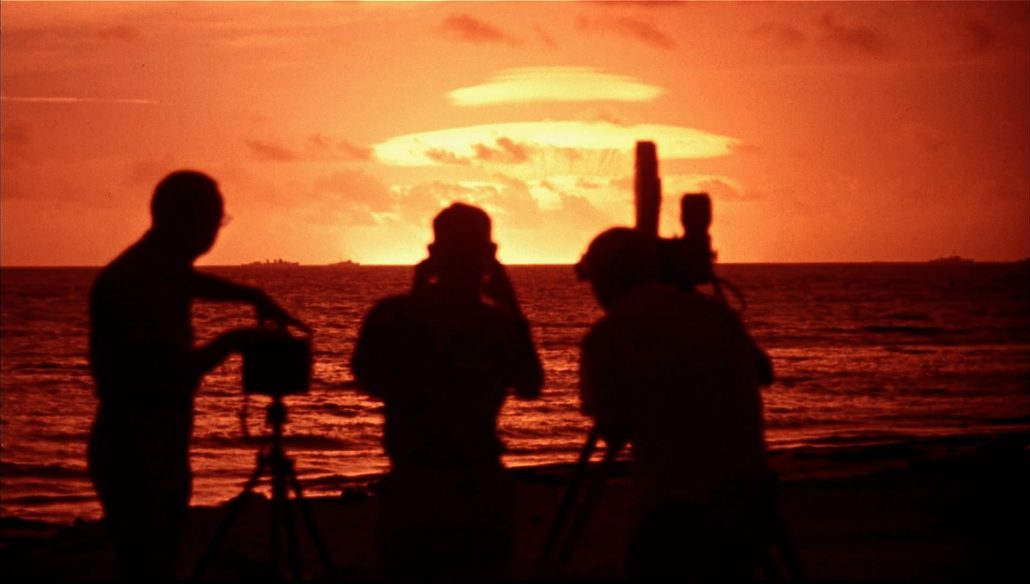
Koa was a surface mounted weapons development test on Teiter island for an XW-35 ICBM warhead, with a nominal yield of 750 kilotons, 1 megaton predicted. It was detonated on May 13, 1958. At 0630 the Koa device was detonated at the western side of Dridrilbwij. The size of the blast was 1.37 megatons, around 76 times larger than Cactus. The test was conducted in a large water tank. Within 17 minutes of the blast, surface clouds reached approximately 60,000. Fallout predictions for Koa were larger and covered a broader range than Cactus, with significantly higher radiation levels, an order of magnitude larger, in the immediate region surrounding the blast. The Koa device caused complete destruction of the island.
Wahoo
Wahoo, a 9 kiloton device, was detonated in the open ocean outside the Enewetak lagoon on May 16. Like its predecessor, Wigwam, conducted off the California coast, the Wahoo shot was a weapons effect test of an underwater nuclear blast on Navy ships. The device was positioned 500 feet deep in the Pacific Ocean. This deep water test required precise target arrays to be set up around the blast location, which presented unique problems as winds and sea currents ha d to be within quantifiable limits so as to be of the needed accuracy. Testing arrays were placed at depths of 400 to 800 fathoms (2400 to 4800 feet) around the device. The deep water mooring systems needed for the test proved to be difficult to be put in proper placement leading many analysts to believe the data to be skewed. Enewetak is a seamount and the ocean outside the lagoon rapidly slides off into very deep water. The target ships to be used on this shot consisted of three destroyers, an active submarine, a submarine mockup used in the Wigwam tests, and a merchant marine ship.
Holly
Holly was detonated at 6:30 am on May 21, 1958. It was one of the 18 blasts on or in the waters immediately surrounding Runit, this one on a barge 4,000 feet from the nearest edge of the island, producing a 5.9 kiloton explosion.
Yellowwood
Yellowwood was a barge-mounted warhead test in the lagoon near Enjebi, nominally rated at 2.5 megatons. The date was May 26 so it’s easy to see how thick and fast the tests were coming. The test was a fizzle and produced a 330 kiloton blast instead and doubtless contributed mightily to the amount of radioactivity in the lagoon sediment. A modified version of the Yellowwood design was later successfully fired in Hardtack Oak.
Magnolia
Magnolia was detonated at 06:00 on May 27, 1958, from a barge 3,000 feet southwest of the center of Runit, and produced a 57 kiloton yield.The detonation produced a 44,000-foot cloud that stabilized at 41,000 feet with its base at 15,000 feet.
Tobacco
Tobacco was detonated at 2:15 pm on May 30, 1958. It was an exploratory shot of an XW-50 Nike-Zeus prototype. The second stage failed to ignite and resulted in a fizzle. It was detonated on a barge 3.000 feet northwest of Enjebi and produced only an 11.6 kiloton blast. The detonation produced an 18,000-foot cloud that stabilized at 16,000 feet.
Rose
Rose was a June 3 exploratory barge-mounted shot of a possible XW-49 warhead. 125 kilotons was the expected yield but again, the second stage failed to ignite resulting in a fizzle. It produced just a 15 kiloton blast. More plutonium on the lagoon bottom.
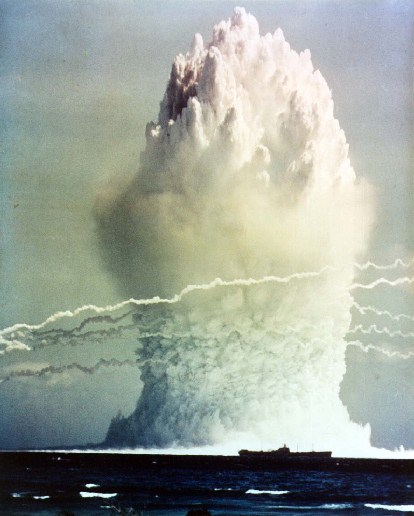 Umbrella
Umbrella
Umbrella
Umbrella was a DoD weapons effects test of an underwater explosion. An 8 kiloton Mk-7 bomb was used for the test, very similar to the Wahoo device. It was detonated on the lagoon bottom, about 150 ft below the surface, NNE of Mut Island. A crater 3000 feet across and 20 feet deep resulted on the lagoon floor.
Walnut
Walnut was another barge-mounted thermonuclear prototype development test with a total yield of 1.4 megatons. Walnut was detonated 5,000 feet southwest of Enjebi Island in Enewetak. The detonation produced a 61,000-foot cloud.
Linden
Linden was detonated on June 18, 1958, at 3:00 pm. Linden was detonated on a barge 4,000 feet west of the center of Runit Island. The detonation produced a 20,000-foot cloud with a 7,000-foot base and produced an 11 kiloton explosion.
Elder
Elder was the second of a tandem shot with REDWOOD (detonated an hour earlier on Bikini). Elder was a barge detonation 1 nautical mile southeast of Enjebi. Initial mushroom cloud height was well over 65,000 feet and produced an 880 kiloton yield.
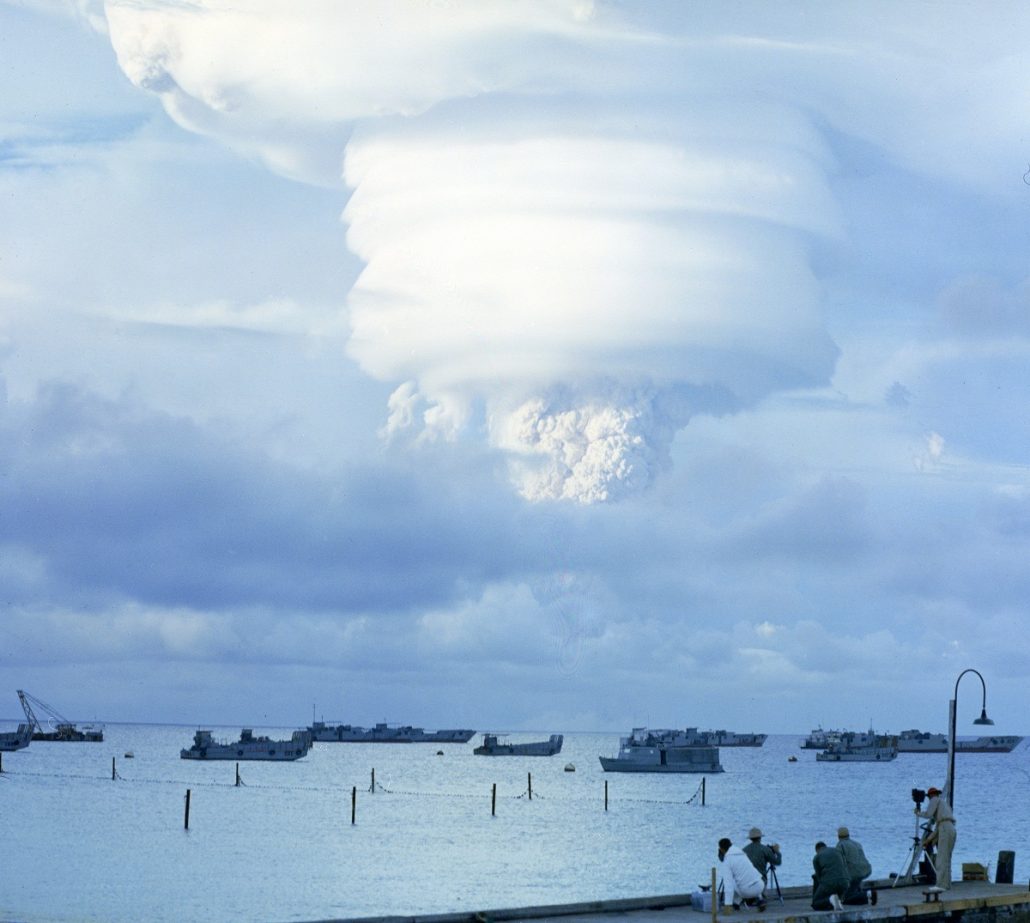
Oak Oak
Oak, another barge-mounted test, was very similar to the Yellowwood device but with a stronger second stage. The results could not have been more profoundly different. Oak had a predicted yield of 7.5 megatons but actually delivered 8.9. It was the 6th largest explosion in the history of the US tests. At just 37 inches in diameter and 100 inches long Oak was compact, just what was needed for a missile warhead. Oak was detonated in just 12 ft of water, in the lagoon southwest of Bokoluo Island, leaving a crater 5740 feet diameter and 204 feet deep on the atoll floor.
Sequoia
Sequoia was detonated on July 2, 1958, at 6:30 am. It was detonated on a barge 2,000 feet west-northwest of Runit. The cloud stabilized at 15,000 feet and produced a 52 kiloton yield.
Dogwood
Dogwood was detonated on July 6, 1958, at 6:30 am. It was detonated on a barge southwest of Enjebi, 4,000 feet from the edge of the island. The cloud rose to 58,000 feet, stabilizing at 54.000 feet with a 35.000-foot base, and produced a 397 kiloton yield.
Scaevola
Scaevola was detonated on July 14, 1958, at 4:00 pm. Scaevola was detonated on a barge west of Runit. Its yield was low and the explosion did not destroy the shot barge but only damaged it, producing a 0 kt yield range.
Pisonia
Pisonia was detonated on July 18, 1958, at 11:00 am. It was also detonated on a barge 10,000 feet west of Runit. The cloud rose immediately to 55,000 feet and produced a 255 kiloton explosion.
Olive
Olive was detonated on July 23, 1958, at 8:30 am. It was another barge detonation, southwest of Enjebi, 4.000 feet from the nearest land at Enewetak. The cloud rose to 50,000 feet with an estimated 15,000-foot base and produced a yield of 202 kilotons.
Pine 2 megatons
Pine was detonated on July 27, 1958, at 8:30 am. Pine was yet another barge detonated weapon, southwest of Enjebi, 8,500 feet from the nearest land. The cloud rose quickly to 66,000 feet with an estimated 38,000-foot base as measured by radar, and had a yield of 2 Megatons.
Teak
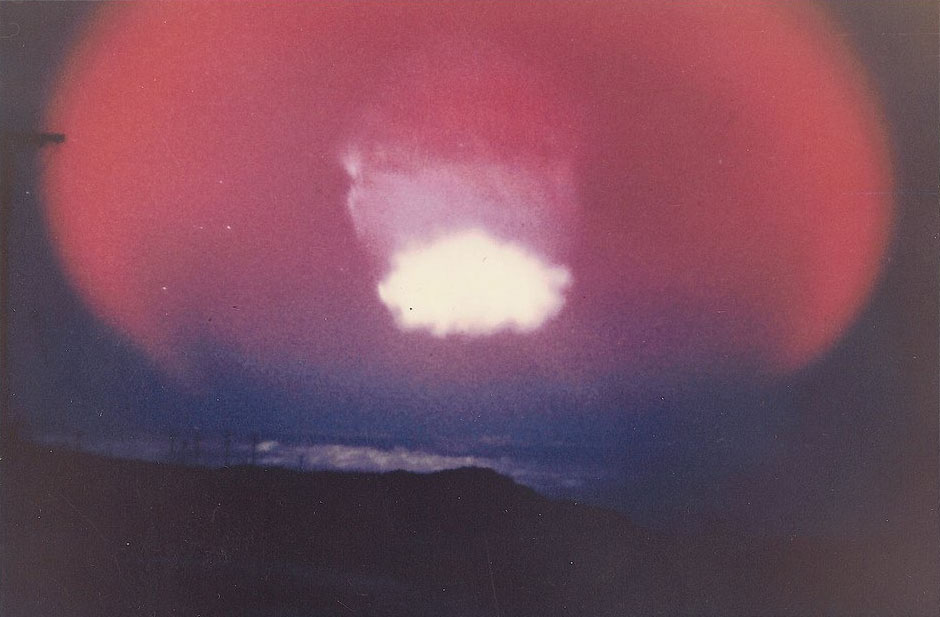
Teak was a high atmospheric test conducted over Johnson Atoll, about 1900 miles to the East of Enewetak, and produced an unexpected EMP pulse, causing damage to land-based electronics as far as 1500 km away. The detonation spread a layer of fission debris in the upper atmosphere, destroying the ability of the upper atmosphere to reflect radio waves back to earth, cutting trans-Pacific communications for hours. The blackout lasted 9 hours in Australia, and 2 hours in Honolulu. Realizing they had a new weapon in their arsenal, these pulse effects were investigated again in 1958 during Operation Argus.
Quince Teak
Quince and Fig were a series of surface shots that occurred in early August at the center of Runit. They were the last of the Hardtack tests conducted at the Enewetak Atoll. Quince was detonated at 2:15 pm on August 6, 1958. Twelve days later, the Fig device was detonated on August 18, 1958 at 4:00 pm. Quince and Fig were UCRL devices with co-sponsorship through the DOD and the AEC, though the main focus of these tests was weapons development. One of the main differences between these two tests was that over 130 tons of soil from the Nevada Test Site had been shipped in and was placed at surface zero of the Fig test. The radioactive cloud from the Quince blast rose to 1,500 feet. The plan called for the same site on Runit to be used for the detonation of Fig so the area had to be decontaminated after the Quince test. Around three to five inches of contaminated topsoil was removed from an area 75 feet by 25 feet upwind of ground zero. An area of 60 square feet at the blast site was scraped to remove the top three inches of soil as well. Even with these precautions, the measured alpha activity was around 20,000 counts per minute (CPM), and the area closest to surface zero was roped off to prevent personnel from entering. Upon detonation, the mushroom cloud produced by the Fig device rose to approximately 6,000 feet, with a base of roughly 4,300 feet. Thirty minutes after detonation, radiation measurements at the blast site reached over 10,000 R/hr.
Fig 20 tons
 Fig
Fig
| Test Name | Time and Date (GMT) | Location | Test Type | Height (Ft) | Yield – Actual (Predicted) kilotons | Sponsor | Purpose | Comments |
|---|---|---|---|---|---|---|---|---|
| Yucca | 2:40 28-Apr-58 | 85 nm NE of Enewetak | Balloon | 85,250 | 1.7 (1.7) | DOD | WE | High altitude test of W-25 for ABM use |
| Cactus | 18:15 5-May-58 | Enewetak | Surface | 3 | 18 (13-14) | LASL | WD | MK-43 primary test in thermonuclear mockup, similar to Elder |
| Fir | 17:50.00.1 11-May-58 | Bikini | Barge | 10 | 1360 (1500) | UCRL | WD | Clean 2-stage thremonuclear device, only 90 kilotons fission (6.6%) |
| Butternut | 18:15 11-May-58 | Enewetak | Barge | 10 | 81 (105) | LASL | WD | TX-46 primary test, similar to Oak and Yellowwood |
| Koa | 18:30.00.1 12-May-58 | Enewetak | Surface | 3 | 1370 (1750) | LASL | WD | XW-35 ICBM warhead, fission yield 750 kt (1 Megaton predicted) |
| Wahoo | 1:30 16-May-58 | Enewetak | Underwater | -500 | 9 (-) | DOD/LASL | WE | Mk-7 deep water effects test, water depth 3200 ft. |
| Holly | 18:30 20-May-58 | Enewetak | Barge | 13 | 5.9 (11) | LASL | WD | XW-31Y3 proof test |
| Nutmeg | 21:20 21-May-58 | Bikini | Barge | 12 | 25.1 (8-25) | UCRL | WD | 2-stage thermonuclear device, possible XW-47 prototype |
| Yellowwood | 2:00 26-May-58 | Enewetak | Barge | 11 | 330 (2500) | LASL | WD | “Clean” TX-46 fizzle (predicted fission yield 200 kilotons), low level burning in 2nd stage |
| Magnolia | 18:00 26-May-58 | Enewetak | Barge | 14 | 57 (55) | LASL | WD | Proof test of Cougar device |
| Tobacco | 2:15 30-May-58 | Enewetak | Barge | 11.6 (175) | LASL | WD | Exploratory shot, XW-50 Nike-Zeus prototype, 2nd stage failed to ignite | |
| Sycamore | 3:00 31-May-58 | Bikini | Barge | 12 | 92 (5 mt) | UCRL | WD | “Clean” TX-41 fizzle; predicted yield 5 Megaton total, 200 kiloton fission; low level burning in 2nd stage; similar to Poplar and Pine |
| Rose | 18:45 2-Jun-58 | Enewetak | Barge | 15 | 15 (125) | LASL | WD | Exploratory shot, possible XW-49, 80 kiloton fusion expected, 2nd stage failed to ignite |
| Umbrella | 23:15 8-Jun-58 | Enewetak | Underwater | -150 | 8 (-) | DOD | WE | Medium depth underwater effects test, Mk 7 used |
| Maple | 17:30 10-Jun-58 | Bikini | Barge | 12 | 213 (225) | UCRL | WD | “Dirty” 2-stage test, predicted to be 89% fission |
| Aspen | 17:30 14-Jun-58 | Bikini | Barge | 11 | 319 (300) | UCRL | WD | Possible XW-47 prototype, 2 stage, 150 kiloton fission yield expected, fired in Bravo crater |
| Walnut | 18:30 14-Jun-58 | Enewetak | Barge | 7 | 1.45 (1.3) | LASL | WD | Thermonuclear prototype development test |
| Linden | 3:00 18-Jun-58 | Enewetak | Barge | 8 | 11 (12-13) | LASL | WD | Possible XW-50 primary |
| Redwood | 17:30 27-Jun-58 | Bikini | Barge | 11 | 412 (300-500) | UCRL | WD | Possible XW-47 prototype, 2-stage, 250 kiloton fission yield expected; similar to Aspen, Nutmeg, Dogwood devices |
| Elder | 18:30 27-Jun-58 | Enewetak | Barge | 9 | 880 (800) | LASL | WD | TX-43 laydown bomb test, 50% fission yield expected, similar to Cactus |
| Oak | 19:30 28-Jun-58 | Enewetak | Barge | 7 | 8900 (7500) | LASL | WD | TX-46/53 prototype test, beefed up 2nd stage after Yellowwood failure |
| Hickory | 0:00 30-Jun-58 | Bikini | Barge | 12 | 14 (8-12) | UCRL | WD | Possible XW-47 primary test, similar to Hardtack II Neptune and Titania |
| Sequoia | 18:30 1-Jul-58 | Enewetak | Barge | 7 | 5.2 (5) | LASL | WD | Similar to Hardtack II Otero, test of Hardtack I Pisonia primary |
| Cedar | 17:30 2-Jul-58 | Bikini | Barge | 11 | 220 (100-200) | UCRL | WD | 2-stage “clean” thermonuclear device, predicted fission yield 30 kilotons |
| Dogwood | 18:30 5-Jul-58 | Enewetak | Barge | 12 | 397 (300-500) | UCRL | WD | Similar to Redwood, Aspen, Nutmeg; possible XW-47 prototype, Piccolo 2nd stage, predicted fission yield 250 kilotons |
| Poplar | 3:30 12-Jul-58 | Bikini | Barge | 12 | 9300 (5000-10000) | UCRL | WD | TX-41 “clean” 2-stage variant; predicted yield 5-10 Megatons total, similar to Pine and Sycamore; largest of Hardtack I, and 5th largest U.S. test ever |
| Scaevola | 4:00 14-Jul-58 | Enewetak | Barge | 20 | 0 (0) | LASL | ST | XW-34 1-point safety test, successful |
| Pisonia | 23:00 17-Jul-58 | Enewetak | Barge | 6.5 | 255 (150-200) | LASL | WD | Probable XW-50 thermonuclear prototype, modified Tobacco device, used Sequoia primary, predicted fission yield was 100 kilotons |
| Juniper | 4:20 22-Jul-58 | Bikini | Barge | 12 | 65 (0.2-60) | UCRL | WD | “Most radical UCRL shot”, “entirely new concept”, last Bikini atmospheric shot, probable XW-47 candidate |
| Olive | 20:30 22-Jul-58 | Enewetak | Barge | 8 | 202 (50-125) | UCRL | WD | Concept feasibility test, 2-stage thermonuclear device, established high yield/light weight; weight 100 kg (yield/weight ratio 2 kt/kg) |
| Pine | 20:30 26-Jul-58 | Enewetak | Barge | 8 | 2000 (4000-6000) | UCRL | WD | TX-41 “clean” 3-stage variant; predicted yield 4-6 Megaton total; similar to Poplar and Sycamore |
| Teak | 10:50 1-Aug-58 | Over Johnston Island | Redstone Rocket | 252,000 | 3800 (-) | DOD | WE | ABM effects test, W-39 warhead, 1.9 Megaton fission yield |
| Quince | 2:15 6-Aug-58 | Enewetak | Surface | 3 | 0 (-) | UCRL/DOD | WD | Probable XW-51 test, fizzle |
| Orange | 10:30 12-Aug-58 | Over Johnston Island | Redstone Rocket | 141,000 | 3800 (-) | DOD | WE | ABM effects test, W-39 warhead, 1.9 Megaton fission yield |
| Fig | 4:00 18-Aug-58 | Enewetak | Surface | 0 | 0.02 (-) | UCRL/DOD | WD | Probable XW-51 test, similar to Quince, successful, last atmospheric shot at Enewetak |
